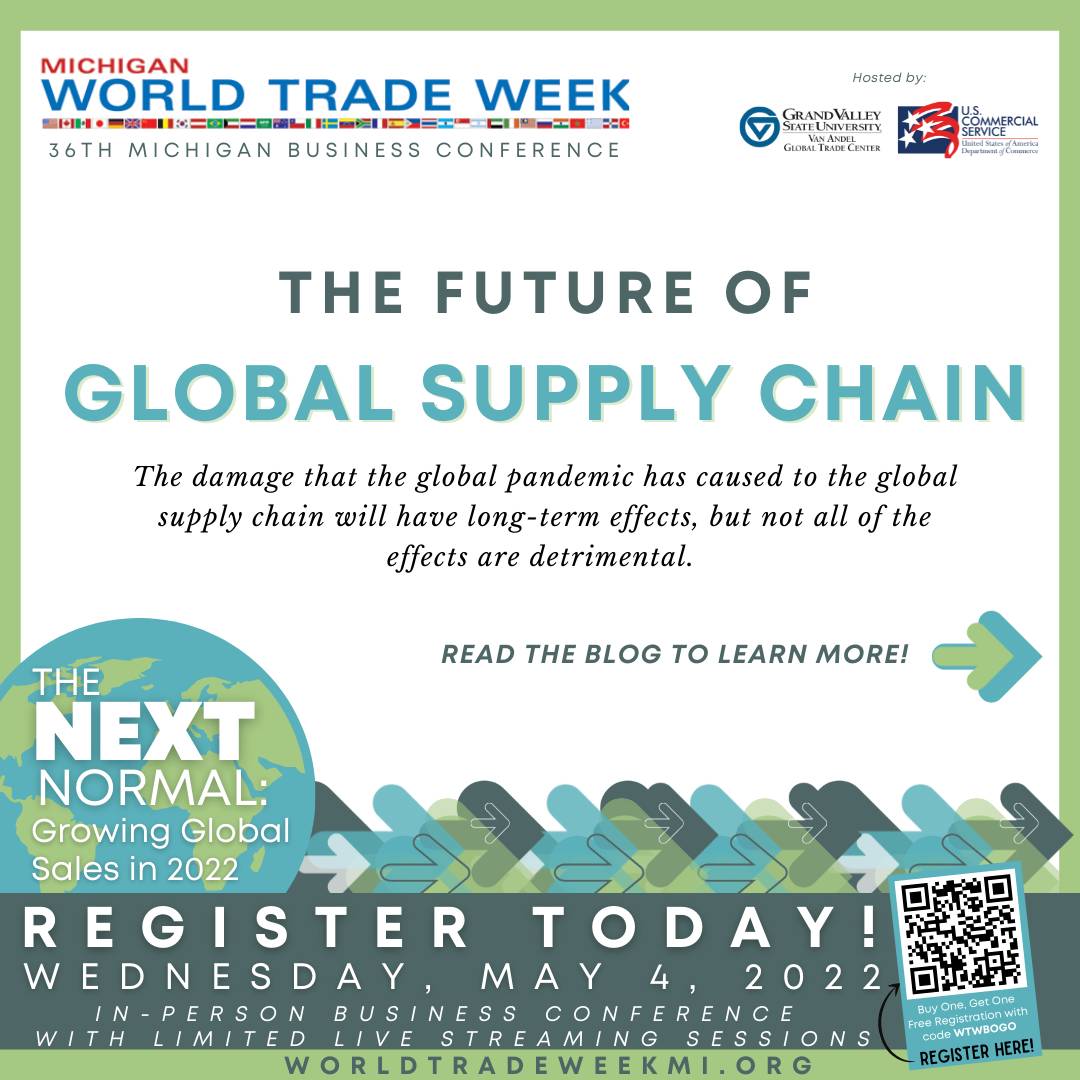The Compass Blog
Permanent link for Commerce in Canada on April 14, 2023
The view of Canada across the Detroit River is a perfect skyline, with the vibrant Canadian flag waving to newcomers. These bustling establishments are just a few extant examples of Canada’s lucrative economy, which had a GDP of $2.200 trillion USD as of 2023.
This economy is sustained through a well-educated workforce, a stable banking system, and plentiful natural resources. These advantages are well-utilized in the many trade organizations Canada is a member of, including the European Union’s Comprehensive Economic and Trade Agreement, the Comprehensive and Progressive Agreement for Trans-Pacific Partnership, and, most relevant to Michigan businesses, the United States–Mexico–Canada Agreement (USMCA)--called CUSMA in English-speaking Canada. These trade agreements give Canada access to many foreign markets.
However, Canada’s largest trading partner remains the United States. According to the International Trade Administration, “The United States and Canada enjoy the world’s largest and most comprehensive trading relationship that supports millions of jobs in each country and constitutes a US$1.7 trillion bilateral trade and investment relationship.”
In spite of this positive trade relationship and Canada’s overall economic prosperity, there are a few things to keep in mind when doing business in Canada.
Cultural Similarities
While Canada and the U.S. share some cultural similarities, such as language, religion, and demographics, it is important to remember that “Canadians and Americans should not be thought of as interchangeable, and it is an etiquette faux pas to act as if that were the case”. In particular, the province of Quebec tends to expect more formality.
Additionally, U.S. businesses should consider language differences. While many Canadians are fluent in both English and French, there are parts of the country where one is preferred over the other, and both English and French translations are appreciated, if not required.
Sustainability
One of Canada’s most profitable natural resources is its crude petroleum production, derived from the largest oil reserves in the world. However, as concern for the climate rises, Canada is looking towards a more sustainable future. Both its logging and fishing industries have suffered from environmental negligence. American companies should consider sustainable options and alternatives when engaging in Canadian partnerships.
Learn More
To learn more about the benefits of doing business in Canada, please join GVSU’s Van Andel Global Trade Center & the U.S. Commercial Service – Grand Rapids Office on May 3rd, 2023, as they host the 37th Michigan World Trade Week International Business Conference! We will welcome the General of Canada in Detroit, Colin Bird, to give a Canadian Economic Update over lunch followed by a What’s New in Canada breakout session with the Consulate of Canada’s Brittany Foley! Register today!
----
About the Contributor
Parker Mackey is a Student Assistant at GVSU’s Van Andel Global Trade Center. They are a 2nd-year junior pursuing a Bachelor of Fine Arts in Studio Arts, emphasis on painting. They also work for GVSU’s History Department, transcribing for the Library of Congress’s Veterans History Project. They enjoy painting, hiking, and listening to folk punk.
Categories:
Canada
Economic Update
Export
Global Consumer
Posted
on
Permanent link for Commerce in Canada on April 14, 2023.
Permanent link for The Future of Global Supply Chain on April 26, 2022
by Jenna Hoover
From toilet paper to semiconductors, the United States has experienced shortages on many different fronts. The damage that the global pandemic (COVID-19) has caused to the global supply chain will have long-term effects, but not all of the effects are detrimental. Supply chain opportunities following the pandemic include:
Resiliency:
Supply chain resiliency is becoming increasingly important as supply chain risks continue to rise. Short-term delays are expected, according to experts, due to issues with cargo ships, workforce shortages, and supply and demand imbalances. According to a survey conducted by the Wall Street Journal, roughly 45 percent of economists anticipate that improvement of bottlenecks will not occur until the second half of 2022. Companies will need to rebalance on-shore, near-shore, and off-shore manufacturing operations to boost resiliency across all global supply chains. They'll have to maintain and further develop alternate sourcing tactics to reduce reliance on specific suppliers in low-cost locations, as they have for the past two years.
Inventory optimization tactics will continue to be important, assisting decision-makers in identifying vital materials, intermediates, and products, as well as determining how much and where they should be stored across the supply chain. Suppliers, logistics service providers, contract manufacturers, and other essential trading partners will also require improved coordination and visibility.
Technology:
Machine learning and artificial intelligence (AI) will employ amounts of the Internet - of - things and social media data from people, devices, assets, products, and vehicles across the supply chain to automate decision-making in Industry 4.0, which is projected to ramp up in 2022. Predictive analytics, on the other hand, will enable employees to make better educated, critical decisions while also developing new business models.
Industry 4.0 has a lot to offer enterprises that have invested in these technologies, from industrial automation with 5G, improved connectivity, and enhanced AI technologies to intelligent sensors and assets across the supply chain. The focus on enterprises implementing Industry 4.0 within their factories, across the supply chain of smart assets, and into the hands of the customer base will intensify in the coming year.
Specific to the U.S.:
Some U.S. companies are considering relocating manufacturing back to the United States or relocating (near-shoring) manufacturing to northern Mexico. There have been years of dependence on Asian factories, in which the freight rates have exponentially increased, as well as back-ups at ports, and the most current problem - not being able to obtain shipping capacity at all. So, companies are strongly considering moving the production closer to their customers:
- General Motors; planning a $4 billion plan to produce batteries for electric vehicles, in Michigan.
- Toyota; considering a $1.3 billion battery plant in North Carolina.
- Samsung; Considering a $17 billion semiconductor plant in Texas.
These are just a few of the considerations.
Learn More!
Learn more about the Global Supply Chain 2022 and Beyond at the 36th Michigan World Trade Week Business Conference in Grand Rapids, Michigan on May 4th! Keynote presenter, Mark Baxa - President & CEO, Council of Supply Chain Management Professionals (CSCMP) will discuss 'Succeeding in Today's Supply Chain Environment' during his keynote address. After lunch, join us for breakout sessions that will keep the discussion of the global supply chain going! Register today!
--
About the Author
Jenna Hoover is working as a student assistant for GVSU’s Van Andel Global Trade Center. She is a junior at GVSU currently studying Finance and Supply Chain Management within the Seidman College of Business. You can find her visiting local coffee shops as she studies for classes or checks in on her Roth IRA. In her free time, she enjoys walking her dog, Gertrude, and hanging out with friends along the beautiful beaches of West Michigan.
Categories:
Export
Global Consumer
Supply Chain
Posted
on
Permanent link for The Future of Global Supply Chain on April 26, 2022.
Permanent link for The Need-to-Know Global Consumer Trends for 2022 on April 20, 2022
By Natalie Bremmer
With the Covid-19 catastrophe (hopefully) coming to a manageable end, producers all over the world are now faced with a whole new consumer landscape. News ideas, norms, policies, and ways of life have created a blockage for businesses trying to reach the same degree of success with their original pre-pandemic business plans in a post-pandemic climate.
These are the must-know consumer trends businesses need to have in place in order to adapt to the tricky consumer environment in 2022.
Sustainability
After being cooped up inside, people more than ever have been observing the state of the planet and they are not pleased. With this in mind, consumers have opted into more environmentally friendly options with their day-to-day and significant purchases. Items that are reusable, easily recyclable, and even second-hand are on the upswing as of late. Examples of such items include electric or hybrid vehicles, second-hand clothing and furniture, and reusable water bottles in lieu of disposable plastics.
Buyers are also looking for businesses that, while in the production process, are actively using sustainable processes to reduce the amount of pollution they pump out into the air, water, and land. Consumers are also looking for companies that present evidence of reducing their carbon footprint impacting the atmosphere.
On top of sustainable products and production standards, producers releasing statements regarding their commitment to the environment and possible donations or actions backing said statements is another way to garner greater attention and support from the general public with a post-pandemic mindset.
Technology & Digitalization
Consumers want information and they want it now. The days of calling a helpline and waiting on hold for half an hour to learn more specific information are gone; customers are going to “google it” or find it on the company website. If they can’t, they will go buy from someone else whose information is more readily available. This can be easily done by making the company website more user-friendly, updating it with the most recent information, creating an app highlighting exclusive deals and news, and being more transparent about company ordeals– barring oversharing or private items of course.
People are also buying more electronic devices– especially video games and VR headsets. The trend is showing that consumers are looking for easy entertainment that can be controlled on their own whim. This is likely a thought process carried over from the depths of the pandemic when forms of entertainment outside of the home were shut down and unobtainable.
Ethics
With breaking news plastered to every corner of cyberspace and the pandemic slowing down the usual hectic pace of the world, it’s no wonder that people are starting to pay more attention to recent events. This, in turn, has reflected over into buying habits where consumers are more likely to buy from brands that notice and care about the same issues that they do.
Some common world issues or events that businesses have come to support are the fight against homelessness, natural disaster relief, BLM, women’s rights, LGBTQ+ rights, and most recently support for the Ukraine.
Money Management & Financial Literacy
With the economic upswing post-Covid-19, people are now fulfilling the need to secure themselves financially in order to fend off any other surprise shocks to the world as they know it. People are putting money in savings accounts at increased rates, investing in traditional stocks, even more, dipping into cryptocurrency, and some even dabbling in non-fungible tokens (NFT). Anything that will help aid in these endeavors – be it alternative payment methods, membership deals, or anything of the like – will definitely catch the consumers' eye.
All of these things have one thing in common– CONTROL.
In light of a pandemic shutting things down, inflation, and war; people everywhere feel like their lives are out of control. The most successful companies in 2022 will be the ones that make buyers feel like at least some aspect of their life is in control again.
Focusing on ethics, sustainability, technology, or money management is a great start to grabbing the attention of the consumers; but to really win the dollars of the post-pandemic market, businesses need to target consumers’ need for control in the seemingly out of control world we currently live in.
Learn More!
According to our GVSU student researcher and author, businesses that can adapt to these trends will be better positioned to satisfy their ever-evolving consumers’ demands in 2022. For additional global consumer trends identified by Euromonitor International , attend the 36th Michigan World Trade Week Business Conference in person or by live stream on May 4th, in Grand Rapids, Michigan. The gathering of industry professionals is a great source of information on how to navigate the next normal way of trade. Register today !
---------------
About the Author
Natalie Bremmer is a Student Assistant at GVSU’s Van Andel Global Trade Center . She is a sophomore currently pursuing an undergraduate degree in Finance and Human Resource Management at Grand Valley State University. She enjoys lifting weights, playing video games, spending time with friends, and going on long hikes.
Categories:
Export
Global Consumer
Trends
Posted
on
Permanent link for The Need-to-Know Global Consumer Trends for 2022 on April 20, 2022.




